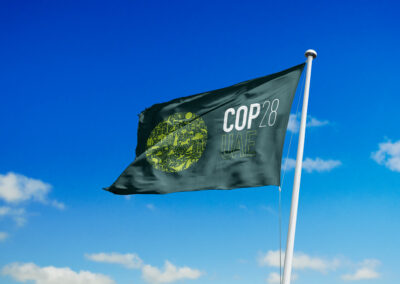nature-based solutions
what are nature-based solutions?
Nature-based solutions (NbS) are ways of working with nature for the benefit of both people and biodiversity. They involve a wide range of actions, including protecting existing ecosystems, restoring degraded landscapes, sustainably managing ecosystems and creating new ecosystems. NbS can deliver multiple benefits for society and nature simultaneously. One of these benefits is sequestering and storing carbon, so NbS have an important role to play on the path to net zero. They also have a number of additional benefits, including helping people adapt to the impacts of climate change, improving human health and wellbeing, providing sources of income, and boosting biodiversity. Hence, NbS form a central part of integrated sustainable development strategies.
Nature-based Solutions are key to reaching net zero, but only if implemented alongside rapid cuts in fossil fuel emissions.
Key facts
WHAT Is NATURE'S ROLE IN REACHING NET ZERO?
Ecosystems naturally act as both sinks and sources of greenhouse gas emissions – they take up CO2 in photosynthesis and can release emissions e.g. if they are cut or burned down. Therefore, it is crucial for reaching net zero emissions that we both minimise emission release and enhance carbon uptake from ecosystems. The estimated mitigation potential of NbS if scaled-up, through avoiding carbon sources and enhancing carbon sinks, is roughly 10 gigatonnes CO2 per year (Girardin et al. in press). This is around 27% of global annual emissions (37 gigatonnes CO2 in 2018).
To minimise emission release from ecosystems, action must be taken to keep existing ecosystems and the carbon they hold intact. This means halting nature loss and degradation, by eliminating deforestation from supply chains, and preventing loss and damage to other ecosystems. It also includes management of ecosystems to make them less likely to release emissions, such as by making them more resilient to fire (Wiedinmyer and Hurteau 2010; Russell-Smith et al. 2016). Current rates of habitat destruction and climate change risk pushing us beyond tipping points where forests dieback due to fire and drought, releasing CO2 on a grand scale (Lenton et al. 2008; Boers et al. 2017; Lovejoy and Nobre 2019).
To enhance carbon uptake by nature, we can restore, manage and create new ecosystems. The best-known NbS of this kind are planting trees to restore forests, or creating new forests on degraded or agricultural land. Whilst forestation has an important role in climate change mitigation, other ecosystems also have crucial parts to play and are due greater attention (Seddon et al. 2020). It is important to use a variety of types of nature-based solutions to maximise their potential for climate change mitigation, as well as climate change adaptation and other benefits for people and nature. Although the exact climate change mitigation potential of NbS is debated, there is broad agreement that this potential is large: a recent estimate found that restoring 15% of terrestrial biomes that have been converted to agricultural land could sequester 299 gigatonnes CO2 (30% of total CO2 increase in the atmosphere since pre-industrial times), whilst simultaneously avoiding 60% of expected species extinctions.
Of all the methods of carbon dioxide removal, NbS are the most ready to be implemented at scale (Field and Mach 2017). It is also of great importance to start upscaling NbS now, to enable them to fulfil their potential for contributing to carbon storage (Qin et al. 2020). This is because it takes time for carbon to be accumulated by ecosystems – trees and other plants that we plant now will continue growing a sequestering carbon for decades to come. Some ecosystems, such as tropical forests, sequester carbon until they reach maturity after several decades, at which point they become more or less static stores of carbon (Canadell et al. 2007). Other ecosystems, such as peatlands, mangroves and seagrass meadows, continue to sequester carbon year on year, and in the absence of human disturbance will not saturate within the timescales relevant to climate change (Rydin and Jeglum 2006; Inoue 2019; Miyajima and Hamaguchi 2019; Gallego-Sala 2018). Although there is a need for haste in implementing NbS, quality must not be compromised, since this could lead to creation of unstable carbon stores, and detrimental effects on biodiversity and people, such as by compromising water security.
HOW PERMANENT ARE NATURAL CARBON STORES?
Natural carbon stores can last for millenia if properly protected and managed, and if not compromised by adverse climatic conditions (Rydin and Jeglum 2006). For example, carbon stored in forests, wetlands and grasslands risks being released back into the atmosphere due to fires in years to come; although some fire is a natural process which maintains the health of the ecosystem, the increasing frequency and severity of wildfire caused by climate change, means the risk of carbon release caused by fire is increasing (Stephens et al. 2013). Managing vulnerable ecosystems to reduce fire risk, and having efficient fire response strategies, can help mitigate the risk of carbon release.
However, as climate change progresses, the resilience of natural carbon stores will decrease (Mitchard 2018). Therefore, it is of critical importance that global-scale implementation of NbS occurs alongside deep and rapid cuts in fossil fuel emissions. If global warming exceeds 2°C above pre-industrial levels, then the ability of natural ecosystems to store carbon will be severely compromised, leading to large-scale CO2 release and acceleration of climate change. Hence rapid action must be taken across all sectors to cut emissions, and ensure that temperatures peak this century, at or below 2°C (Griscom et al. 2017; Anderson et al. 2019). Large-scale implementation of NbS makes an indispensable contribution to this goal; if, for example, we peak at 2°C warming around 2075, then this NbS will mitigate 0.3°C of warming (Girardin et al. in press).
To summarise:
- NbS can provide carbon storage for millenia, but there is a risk of carbon being released.
- The risk of carbon release can be decreased by good management on the ground, and rapid emission cuts across all sectors.
- In spite of the risk of carbon release, NbS make an indispensable contribution to reaching net zero emissions, and failure to implement them at scale would lead to worse climate change.
HOW CAN THE SUCCESS OF NBS PROJECTS BE ENSURED?
To ensure that NbS are efficient at taking up and storing carbon for the long term, they must be carefully designed to each specific context, informed by the best possible science and local and indigenous knowledge. This is also needed to ensure that NbS do not have negative social, ecological and biophysical side effects. Poorly implemented NbS have in the past led to land grabs, human rights abuses, biodiversity loss and water shortages (Lyons and Westboy 2014; Buck 2016; Brancalion and Chazdon 2017; Chausson et al. 2020). However, well-planned NbS can act as a positive force for nature and local people, whilst also mitigating climate change (Seddon et al. 2020).
The following four simple principles can guide NbS projects to ensure they are both successful and sustainable:
- NbS are not a substitute for rapid cuts in fossil fuel emissions.
- All marine and terrestrial ecosystems are important for NbS.
- Indigenous Peoples and local communities must be the main stewards and beneficiaries of NbS.
- NbS must support biodiversity and ecosystem health.
Read more about these principles here, which were originally outlined in a letter to the COP26 president.
In addition, the International Union for the Conservation of Nature (IUCN) has published a Global Standard for NbS, which provides more detailed guidance on how to implement NbS with integrity.
SHOULD NBS BE USED FOR CARBON OFFSETS?
Since NbS sequester carbon, they are commonly used to ‘offset’ emissions produced by other means. Although offsetting is a legitimate method for funding NbS, and it can play an important role on the path to net zero emissions, it is associated with a number of problems that must be addressed:
- Offsetting has been used as an excuse for not cutting emissions, allowing environmentally destructive activities to continue under the green veil of NbS. Therefore, offsetting (by NbS or other means) must only be used by companies that have rigorous emission reduction strategies.
- NbS offsetting projects have sometimes led to land grabs, human rights abuses, and other negative consequences for local people. Therefore, offsets must only fund NbS that have socially-just governance structures, and a sufficient level of engagement with local communities.
- Some projects labelled as NbS have had detrimental ecological side effects. Therefore, offsets must only fund NbS that have undergone full ecological assessments.
- Offsetting has sometimes funded creation of ecosystems with low resilience to environmental change and hence unstable carbon stores. Therefore, offsets must only fund NbS that have been designed to be ecologically resilient to climate change and other threats such as pests and disease; this includes, for example, planting mixtures of carefully chosen, stress tolerant tree species, rather than just one fast growing species.
For further guidance on using NbS as offsets as part of a genuine net emission reduction strategy, see the Oxford Principles for Net Zero Aligned Carbon Offsetting, and to ensure the NbS funded have social and ecological integrity, follow the IUCN Global Standard for NbS.
Types of Nature-based solutions
FORESTS
The current carbon stock in the world’s forests is around 860 gigatonnes of carbon (Pan et al. 2011). From 2001-2019 there was a 9.7% decrease in global tree cover, releasing 105 gigatonnes of CO2 (equivalent to 29 gigatonnes of carbon) (Global Forest Watch 2020). It is critical to end deforestation and keep carbon locked up in forests rather than letting it enter the atmosphere. This means eliminating deforestation from supply chains, which includes displacement of deforestation elsewhere, e.g. if one crop displaces another, the demand for which is then met by deforestation (Lambin et al. 2018). Intact forests also continue to sequester carbon – forests globally together currently do this at a rate of about 1.1 gigatonnes of carbon per year (Pan et al. 2011), although this carbon sink is gradually saturating (Hubau 2020).
Restoring forests, improving management of existing forests, and growing trees on degraded or agricultural land, also has great potential as a carbon sink. As trees and other forest plants grow, they absorb CO2 from the atmosphere and store it in living plants, dead organic matter and soils. Regrowing natural forest can sequester carbon at an estimated rate of 3.16-3.58 megatonnes of carbon per hectare per year (Cook-Patton et al. 2020; Griscom et al. 2017). However, forests are not the only carbon-rich ecosystem, and we must restore more ecosystems than just forests if we are to achieve the maximum climate change mitigation and biodiversity benefits (Strassburg et al. 2020).
Protecting and restoring forests is also of great value for adapting to climate change, such as by increasing water quality and availability, reducing flooding, preventing landslides and providing food for times of shortage (Chausson et al. 2020). Forest stewardship also supports livelihoods of people – 86 million green jobs are currently provided by forests, and 90% of people living in extreme poverty are dependent on forests for part or all of their livelihoods (FAO 2020). Furthermore, forests are crucial havens of biodiversity – collectively, they are estimated to be home to about 80% of plant and animal species on land (FAO 2020), with tropical forests supporting around two-thirds of land species, despite covering under 10% of Earth’s land surface (Giam 2017).
An example of forest-based NbS providing multiple beneficial outcomes is coffee farm and forest restoration, combined with creation of drainage ditches, in El Salvador, to reduce flood risk and provide additional income for local people from fruit trees. In Burkina Faso, construction of fences to exclude livestock from sections of degraded land allowed trees to regrow, providing products such as livestock fodder and wood for local landowners to use or sell, whilst also increasing carbon sequestration and tree species diversity. An example in a contrasting context is natural regeneration of woodland in the Lake District, UK, to reduce erosion and increase water quality, hence decreasing water treatment costs, whilst also boosting biodiversity.
PEATLANDS
Peatlands are highly efficient carbon sinks, because anoxic conditions prevent decomposition of organic matter, meaning carbon can be locked up for millenia. Peatlands cover 3% of the Earth’s land surface, but account for 21% of global soil organic carbon (Leifeld and Menichetti 2018). Therefore, protecting these existing stores, which can continue to sequester carbon in perpetuity, is critical (Rydin and Jeglum 2006). In addition, 10% of peatlands are degraded due to draining or mining, converting them into sources of carbon. Restoring degraded peatlands by rewetting can turn these sources into sinks, providing a highly cost-effective climate change mitigation strategy, whilst also benefitting biodiversity and still providing income through paludiculture (agriculture on peatlands).
Some examples of peatland restoration on a large scale are in Belarus, where 50,000 ha of degraded peatland were rewetted over a decade, and in Scotland where 25,000 ha have been under restoration since 2012, with a £250 million commitment to expand restoration in Scotland over the next decade.
COASTAL & MARINE
Many coastal and marine habitats, including saltmarshes, mangroves and seagrass meadows, are rich in carbon and have high rates of carbon sequestration; indeed on average they store carbon more rapidly per unit area, and more reliably for longer periods of time, than terrestrial forests (McLeod et al. 2011). For example, mangrove forests sequester carbon 2-4x faster than mature tropical forests. About 67% of mangrove, 35% of saltmarshes and 29% of seagrass meadows have already been lost globally, so protecting these carbon stores is critical (Blue Carbon Initiative 2020). In addition, restoration of coastal and marine ecosystems can sequester large quantities of carbon (Herrera-Silveira et al. 2020; Himes-Cornell et al. 2018). Protecting and restoring coastal habitats is also of great importance for protecting coastlines from flooding and erosion, and providing biodiverse habitats to support fisheries.
An example of coastal NbS providing multiple benefits is a mangrove protection project in India which protects villages and crops from flooding from cyclones, whilst also improving soil fertility and providing nursery grounds for fish. Another is the creation of saltmarsh on the seaward side of dikes in the Netherlands; the marsh reduces wave energy before it hits the dike, which was shown to be more effective than heightening the dike itself for reducing chance of inundation.
AGRICULTURE
Agricultural management utilising ecological concepts and components of natural ecosystems can increase carbon sequestration aboveground and in soils. For example, agroforestry – integration of trees into farmland – enhances carbon sequestration rates of croplands or pasturelands, whilst boosting biodiversity (Nair et al. 2009). Agroforestry is also often more profitable than intensive plantations, due to lower costs of management and higher market prices for products (Jezeer et al. 2017).
Other forms of nature-based agriculture that increase carbon sequestration include addition of organic material to soil, reduced tillage and diversification of crop and non-crop species on farmland; these have the additional benefits of enhancing pest control and pollination, and improving soil fertility and nutrient cycling. Evidence is growing that agricultral practices that embrace biodiversity, on average, increase or maintain crop yields (Tamburini et al. 2020).
Nature-based farming has even been shown to decrease the vulnerability of farmers to the effects of the COVID-19 pandemic. In Guatemala, planting multiple crops amongst each other, sharing seed banks to increase genetic variety, coordination of farming at the community level, and payments for forest management from the government, gave these communities insurance food and savings. This increased their ability to cope when transport was restricted due to the pandemic.
URBAN
Restoring and creating natural habitats within cities has great potential for improving the quality of life of city-dwellers, whilst also contributing to carbon sequestration. Urban NbS are diverse in form, including green roofs and green walls, created wetlands, urban agriculture, street trees and parks – collectively these are often known as urban green and blue infrastructure. They can greatly improve drainage systems leading to reduced flooding, whilst improving air and water quality and helping to cool cities (Keeler et al. 2019). The climate change mitigation potential of urban NbS is substantial (De la Sota et al. 2019), and due to the extensive additional benefits to society, strategically increasing greenery in towns and cities is considered a priority (McPhearson 2020). Urban NbS have potential to benefit very many people directly; in 2020, around 4.4 billion people – 56% of the global population – live in cities, with this expected to increase to 6 billion by 2040 (IIED 2020).
Some examples of successfully implemented urban NbS are urban trees in Wisconsin, USA, cooling the city of Madison; green roofs, rain gardens and stormwater ponds reducing flooding and nutrient runoff in several US settings; and Knowledge Mile Park, the Netherlands, which incorporates green roofs, green walls and vegetated areas to improve drainage, reduce air pollution and grow food, as well as providing sites for university-level education, and bring diverse members of the local community together to collaborate on the project.
The Nature-based Solutions Initiative is an interdisciplinary programme of research, policy advice and education, based at the University of Oxford. Explore the website for more information on NbS, such as recent developments in science and policy, NbS news coverage, case studies, policy briefs, a policy platform and an evidence platform.
Other research themes
greenhouse gas removal
There are various types of Greenhouse Gas Removal (GGR) technologies which recapture already emitted greenhouse gases from the atmosphere and ocean.
Equity AND Inclusion
Pathways to achieving global net zero emissions must be framed by questions of equity and justice. A just transition to a net zero future needs to be inclusive of a range of actors as well as a range of views, including those relating climate justice.
Green Recovery and Resilience
A green recovery from COVID-19 could accelerate GDP growth in the immediate future, establish new industries and jobs for the coming decade, and deliver a sustainable climate for the next century.
News and Events



Onshore geological carbon storage has potential in the UK, but key knowledge and regulatory gaps remain – ONZ report
A new report by a team of Oxford Net Zero researchers reviews the current state of knowledge on onshore geological carbon storage (GCS) and its feasibility in the UK. Read more



Oxford launches revised Offsetting Principles
As part of their net zero strategies, many companies, organisations, cities, regions and financial institutions are relying on voluntary carbon credits to offset their residual emissions. But evidence continues to cast doubt on the integrity of ... Read more



Job Opening at ONZ: Impact and Operations Officer
Oxford Net Zero is looking for a highly organised and motivated Impact and Operations Officer to join its team. You will be working alongside the Programme Manager, Cath Ibbotson, and the Head of Policy and Partnerships, Kaya Axelsson to ... Read more



Net Zero Regulation Stocktake Publishes Results
A new report published by Oxford Net Zero presents a comprehensive ‘stocktake’ of developments in net-zero regulation across the G20 in 2023. It focuses primarily on four regulatory domains: claims and financial products standards, disclosure, ... Read more



New ONZ report on rolling out renewables in the Global South
The scaling up of clean electricity, and using it to decarbonise other parts of the economy, is central to all decarbonisation pathways. In their latest report, “Rolling out renewables in the Global South”, Oxford Net Zero’s Sam Fankhauser ... Read more



Oxford Net Zero at COP28
The Oxford Net Zero community is mobilising its collective expertise to help drive ambition at COP28, being held in the UAE from 30 November – 12 December. Read more
See more news and events
